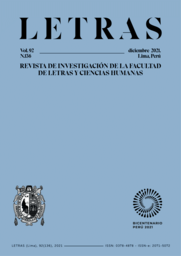The Vibrants of Spanish of the Department of Puno: An Acoustic Characterization
Abstract
This paper provides a phonetic description of the different variants of the simple and multiple vibrants of Spanish in the department of Puno. For this purpose, four collaborators were interviewed and each one had an informal conversation with the interviewer in order to obtain a spontaneous sample. Likewise, the paper is based on two central ideas: 1) due to their heterogeneity, vibrants vary even in the same context, and 2) they are characterized by the number and nature of the components that make them up. The phonetic-acoustic description was based on broadband spectrographic analysis and on the oscillographic analysis of the complex wave, which allowed to report, first, single-component variants (approximant vibrants, approximant vibrants with noise and vibrants realized as occlusion); second, two-component variants (vibrants with a vowel element and an occlusive element, vibrants with a vowel element and an approximant element, vibrants with an element realized as noise and a vowel element, among others); third, three-component variant (vibrants with a vowel element plus an occlusive element plus a vowel element); finally, elisions were reported. In total, twelve different realizations of vibrants have been identified and most of these have not been reported before for the Spanish of the department of Puno.Downloads
Métricas alternativas
References
Blecua, B. (2001). Las vibrantes del español: manifestaciones acústicas y procesos fonéticos. (Tesis de doctorado). Universidad Autónoma de Barcelona, Barcelona, España.
Blecua, B., Cicres, J. y Gil, J. (2014). Variación en las róticas del español y su implicación en la identificación del locutor. Revista de Filología Románica, 31, 13-35. https://doi.org/10.5209/rev_RFRM.2014.v31.n1.51021
Boersma, P. y Weenink, D. (2021). Praat: Doing Phonetics by Computer. (Versión 6.1.41) [Programa de computadora]. https://www.fon.hum.uva.nl/praat/
Bradley, T. y Willis, E. (2012). Rhotic variation and contrast in Veracruz Mexican Spanish. Estudios de Fonética Experimental, 21, 43-74.
Cortez, E. (2014). El español andino en Perú: adquisición, variación y cambio en el habla de Huancayo. (Tesis de doctorado). Universidad de Temple, Pensilvania, Estados Unidos de América.
Elías, J. (2011). Una documentación acústica de la lengua shipibo-conibo (Pano). (Con un bosquejo fonológico). Fondo Editorial de la Pontificia Universidad Católica del Perú. https://repositorio.pucp.edu.pe/index/handle/123456789/174304
Gil, J. (1990). Los sonidos del lenguaje. Síntesis.
Ladefoged, P. y Maddieson, I. (1996). The Sounds of the World’s Languages. Blackwell.
Martínez, E. y Fernández, A. (2013). Manual de fonética española. Articulaciones y sonidos del español (2.a ed.). Planeta.
Muñoz, R. (2020). Finder [Praat plug-in]. Version 2.2. https://github.com/rolandomunoz/plugin_finder
Quilis, A. y Fernández, J. (2003). Curso de Fonética y Fonología españolas para estudiantes angloamericanos. Consejo Superior de Investigaciones Científicas.
Copyright (c) 2021 Letras (Lima)

This work is licensed under a Creative Commons Attribution 4.0 International License.
Este obra está bajo una licencia de Creative Commons Reconocimiento 4.0 Internacional



















